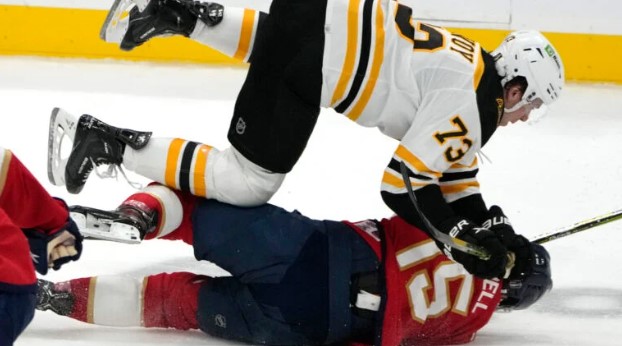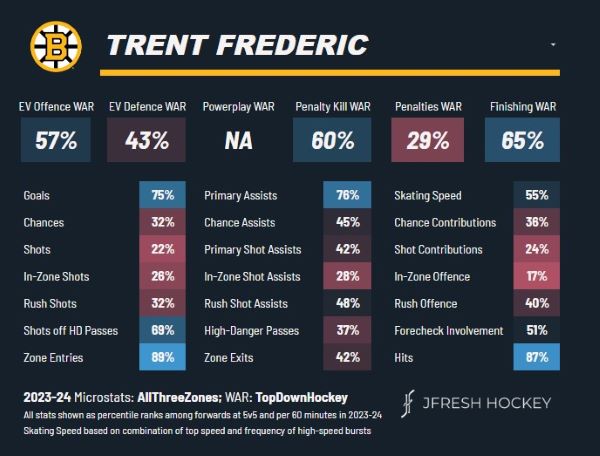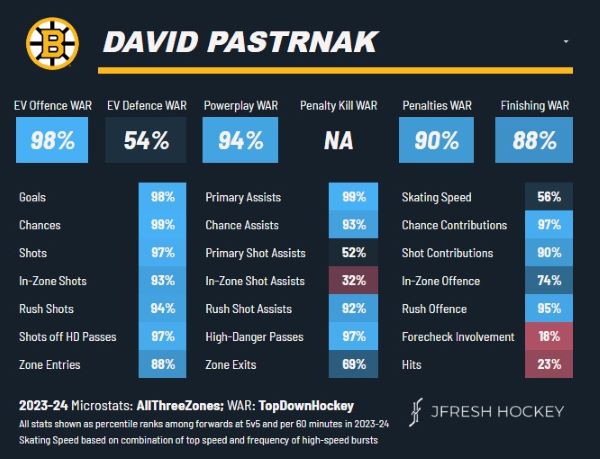
By: Tom Calautti | Follow me on Twitter @TCalauttis
How good were the Bruins in 2023-24? Which parts of their team excelled, and which held them back? What do they need to improve on most? These are the questions every executive sets out to answer in the offseason as they look to strengthen their team. I may not be an NHL Executive, but I figured I would give it a shot and try to assess where the Boston Bruins need the most help using advanced analytics. Now, I know that analytics can seem daunting and complex, but they are one of the best tools for evaluating a roster in an unbiased and impartial manner.
For this exercise, I used the 2023-24 Stat Cards created by JFreshHockey, All Three Zones, and TopDownHockey, three of the best analytics sites in the world. On the cards below, you will see a player’s effectiveness in different game areas, evaluated based on the percentile in which they rank in the league.

I combined the above player cards for each of the ten Boston forwards (Pastrnak, Marchand, Coyle, Zacha, DeBrusk, Frederic, Geekie, Van Riemsdyk, Heinen, and Poitras) and six defensemen (McAvoy, Lindholm, Shattenkirk, Carlo, Lohrei, Grzelcyk) they had available and calculated the team’s average percentile in each component on the card. Here’s what I found:
Help at Center
This first finding was the most obvious to fans, so I attacked it right out of the gate. No matter how you slice it, the Boston Bruins must improve at center if they want to make a run at a Stanley Cup. If you look at the play of Boston’s top two centers (Zacha and Coyle), they fall into the 26th percentile of even-strength offense and the 13th percentile of even-strength defense. Geekie and Poitras’ numbers are somewhat better, but the team needs better play (or better players) at the top of their roster.
Despite their weakness at center, the forward group had a solid year overall. If you factor in the wingers, Boston forwards ranked in the 80th percentile of even-strength offense and were a slightly above-average group defensively, sitting in the 53rd percentile. David Pastrnak’s ridiculous Stat Card inflates those numbers, but the Bruins have a solid group of wingers that can contribute on both ends of the ice.

If Don Sweeney can make an impactful move at center, this team should be able to elevate itself even further.
Speed Kills (and is a Killer)
The Boston Bruins have never been a particularly fast team. Fans used to take pride in how big and physical the team used to be, openly sacrificing speed for strength and physicality. I knew the advanced metrics would show that the Bruins were slow, but I was surprised to see just how slow.
When averaging all of Boston’s forwards together, the team ranks in the 37th percentile in speed, an abysmal number for a team trying to adapt to the newer, faster NHL. I will admit that there weren’t stat cards for Jesper Boqvist, Jakub Lauko, and Johnny Beecher skew these numbers. However, you’ll also notice I didn’t include Justin Brazeau and Patrick Maroon, two players who would even further hinder team speed.
Cam Neely talked about wanting to add faster skaters to this roster at his end-of-season presser, and there’s no arguing that this team could use an infusion of speed to add an extra dimension to their offense.
More Zone Time
When I looked at the numbers, there was only one last area that Boston’s offense needed to improve on in-zone offense. When taking the average of Boston’s ten forwards, I found they are in the 41st percentile on in-zone offense. It became abundantly clear during the Florida series and, at some points, during the Toronto series that Boston may not have the combination of speed, physicality, and battle to put forth a dominant forecheck and establish possession on dump-ins.
According to NHLEdge, the Bruins were in the offensive zone 40.6% of the time in the regular season, which put them below the 50th percentile in the league. That number increased by .1 percentage points in the playoffs, improving to 40.7% of the time in the offensive zone. When you look at those numbers and then consider that Boston lost the shot attempts battle in both the regular and postseason (691-896 in playoffs and 4610-5097 in regular), it becomes clear that this team needs a more sustained attack.
Whether you attribute that to lack of speed, inability to retrieve pucks, or being overmatched, in their end, Bruins management needs to prioritize players that can enhance the team’s forecheck this offseason.
Offense from Defense
According to this exercise, the most glaring area of need for the Boston Bruins to improve on (other than center) is offensive production from their defenseman. In several significant categories, Boston’s defensemen fell woefully short in trying to aid in the offense:
- Even-Strength Offense: 49th percentile;
- Powerplay: 34th percentile;
- Shots: 43rd percentile; and
- Shot Contribution: 47th percentile.
The most jarring of those stats is how ineffective Boston’s defensemen were on the powerplay this season. Charlie McAvoy quarterbacked Boston’s top powerplay and only registered 13 points (tied for 29th in the league). The only other defenseman with double-digit points on the powerplay was Kevin Shattenkirk, and we’re not sure he’ll be back next season. Simply put, the team needs more from their backend with the man-advantage.
In addition to lackluster powerplay numbers, Boston’s defensemen weren’t much better at even strength. Bruins defensemen combined for 151 points in the regular season, good enough for the league’s 27th-highest total, trailed only by Washington, Arizona, Anaheim, San Jose, and Chicago. Every team that advanced further than Boston this season had at least one high-caliber defenseman who could contribute offensively and affect the game on that end of the ice.
The one caveat to this point is Mason Lohrei’s development. His production vastly improved when given increased ice time in the playoffs, and I could see him quarterbacking the first powerplay when next season begins. If he blossoms into the player he’s expected to be, this point will be moot, but until that time, the Bruins need more offense from their defensemen.
So there you have it; that’s at least some of what the analytics tells us the Boston Bruins need to do to improve their roster. If they can acquire some speed, get more assertive on the forecheck, and generate more offense from their defensemen, I like their chances of improving upon last season.


Leave a Reply